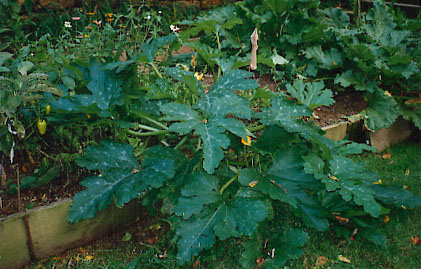
| OUTDOOR APPLICATIONS | PERLITE |
|
PLANTING SHRUBS AND TREES AND IN CONTAINERS AND GARDENS |
PLANT GUIDE |
|
The Schundler Company 10 Central Street Nahant, MA 01908 732-287-2244 |
USING HORTICULTURAL PERLITE
A GOOD PROBLEM SOLVER FOR OUTDOOR GARDENING
Perlite, a standard ingredient in houseplant soil mixes, can help the home gardener solve a multitude of common problems outdoors, explains a spokesman for the Perlite Institute.
 | A Vegatable Garden with Perlite |
Soil in vegetable and flower gardens can be conditioned by cultivating, with a fork or rototiller, to a depth of six to l2inches. A four-inch layer of half perlite and half peat moss may then be worked into the cultivated soil. If the soil if rich in organic material, the peat moss may be eliminated.
The same procedure may be followed in preparing lawn areas for sodding or seeding. Established lawns may also be renovated with horticultural perlite. The lawn area should be spiked or plugged and perlite spread on the surface and raked into the spike or plugholes. The perlite will work its way into the root zone to provide aeration and drainage.
If the garden area is very large, the home gardener may condition only the rows or areas where planting is to take place. Thus, if the procedure is continued for two to three years, the entire gar den area will eventually be conditioned. Because horticultural perlite is inorganic, it will not deteriorate in the soil but will continue to function for many years.
When trees or shrubs are to be planted, a planting pocket six inches larger than the plant roots should be dug. A mixture of one-third each of soil, perlite and peat moss or compost may be used to fill the hole and complete the planting operation. The shrub or tree should be thoroughly watered. The roots of the plant can easily penetrate and develop in the friable growing media.
Perlite is a unique volcanic mineral which expands to about 13 times its original volume when it is heated to a temperature of about 1600 degrees. During the heating process, the mineral particles pop like popcorn and form a granular, snow white material that is so light in weight it weighs only about five to eight pounds per cubic foot.
Each particle of perlite is comprised of tiny closed air cells or bubbles. The surface of each particle is covered with tiny cavities which provide an extremely large surface area. These surface cavities trap moisture and make it available to plant roots. In addition, because of the physical shape of each particle of perlite, air passages are formed in the growing media, thereby providing excel lent aeration.
Fertilizer appropriate to the plants being grown should be added.
Horticultural perlite is available in several different grades. The fine to medium grades are ideal for general gardening applications.

|
For more information about these uses of perlite in containers, landscaping, and/or gardening,
please call or contact us at:
The Schundler Company
10 Central Street
Nahant, MA 01908
(ph)732-287-2244 (fax) 732-287-4185
www.schundler.com
email: info@schundler.com
Back to Horticultural Main Page